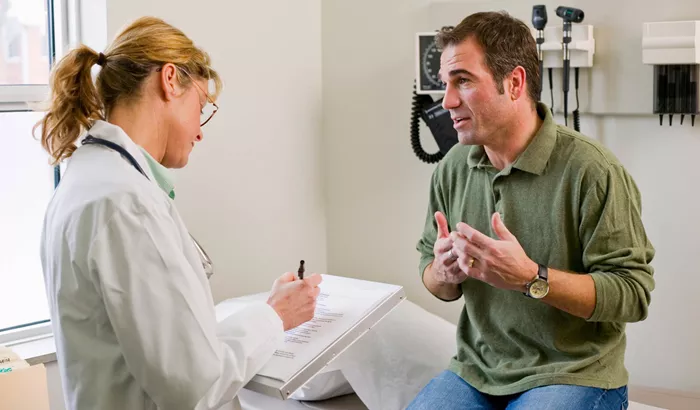Gallbladder pain creates a distinct and often intense discomfort that differs from ordinary stomach aches. This small digestive organ tucked beneath your liver can cause surprising amounts of distress when inflamed or blocked. The pain follows characteristic patterns that help distinguish it from other abdominal issues.
Location of the Discomfort
The pain centers in the upper right abdomen. Just below the rib cage on the right side is where gallbladder distress makes itself known most intensely.
It often radiates to the back. Many people feel the pain travel around to the right shoulder blade or between the shoulder blades in what doctors call referred pain.
Some feel it in the middle upper abdomen. While typically right-sided, gallbladder pain sometimes presents more centrally, just below the breastbone.
The discomfort stays localized at first. Early gallbladder issues cause pain in specific areas rather than generalized abdominal soreness.
Characteristics of the Pain
It builds steadily after eating. Unlike sudden stomach cramps, gallbladder pain typically begins as a dull ache that intensifies over 30-60 minutes following meals.
The pain comes in strong waves. It often peaks sharply before easing slightly, creating a rollercoaster of discomfort rather than constant agony.
Movement makes it worse. Taking deep breaths, coughing, or even walking can intensify the pain significantly during an attack.
Pressure increases discomfort. Pressing on the upper right abdomen elicits tenderness that healthy people wouldn’t experience.
Intensity Variations
Mild cases feel like persistent fullness. Early gallbladder issues may cause only uncomfortable bloating rather than sharp pains.
Moderate attacks create steady aching. Many describe it as someone squeezing or applying constant pressure beneath their ribs.
Severe episodes become excruciating. Intense gallbladder pain leaves people unable to find comfortable positions, often writhing or rocking for relief.
Colicky pain suggests stones. When gallstones block ducts, the pain comes in intense waves as the gallbladder contracts against the obstruction.
Timing of Symptoms
Meals trigger the pain predictably. Symptoms typically begin 30-90 minutes after eating, especially following fatty or large meals.
Nighttime attacks are common. Many experience their worst pain in the evening or overnight as digestion continues during sleep.
Episodes last hours not minutes. Unlike heartburn that comes and goes quickly, gallbladder pain persists for several hours once it starts.
Symptoms recur in similar patterns. People notice the pain returning under comparable circumstances rather than randomly.
Accompanying Sensations
A feeling of intense bloating develops. Even when the abdomen isn’t visibly distended, people report unbearable internal pressure.
Nausea often accompanies the pain. While less likely to cause vomiting than stomach bugs, the queasiness can be persistent and debilitating.
Some experience cold sweats. The body reacts to the intense discomfort with clammy skin and general malaise.
Restlessness is common. Unlike some abdominal pains that make people lie still, gallbladder pain often causes pacing or constant position changes.
Differences From Similar Pains
Heartburn feels more like burning. Gallbladder pain lacks the characteristic fiery sensation of acid reflux moving up the chest.
Appendicitis pain starts elsewhere. While both cause right-sided discomfort, appendicitis typically begins near the belly button before migrating.
Kidney stones create different radiation. The pain from kidney issues tends to travel downward to the groin rather than to the back.
Muscle pain is more superficial. Gallbladder discomfort feels deep inside rather than at the surface where muscular strains occur.
How Children Experience It
Young kids struggle to describe location. Children may simply clutch their entire abdomen rather than pointing to the right upper quadrant.
Symptoms seem less food-related. Pediatric gallbladder issues sometimes cause constant discomfort rather than meal-triggered episodes.
Pain appears more generalized. Instead of clear radiation patterns, children often report the hurt spreading across their whole midsection.
Nausea dominates more than pain. Kids with gallbladder problems frequently complain more of sickness than localized discomfort.
Unique Aspects in Pregnant Women
Discomfort is often misattributed. Many pregnant women mistake gallbladder pain for normal pregnancy aches or heartburn.
Symptoms intensify in third trimester. The growing uterus puts pressure on the gallbladder, making existing issues more pronounced.
Hormones alter pain perception. Pregnancy-related hormonal changes may make gallbladder pain feel different than in non-pregnant individuals.
Morning sickness overlaps. Nausea from gallbladder dysfunction blends with pregnancy nausea, delaying proper diagnosis.
When Pain Signals an Emergency
Fever accompanies the pain. Temperatures above 101°F suggest possible infection in the gallbladder requiring urgent care.
Jaundice develops. Yellowing skin or eyes indicates possible bile duct blockage needing immediate attention.
Pain becomes constant. When waves of pain turn into unrelenting agony, the gallbladder may have ruptured or become necrotic.
Vomiting prevents keeping liquids down. Persistent vomiting with gallbladder pain signals possible obstruction complications.
Factors That Relieve the Pain
Leaning forward sometimes helps. Some find relief by bending at the waist or curling into a fetal position.
Applying heat provides comfort. A warm (not hot) compress on the upper right abdomen eases muscle tension around the inflamed organ.
Slow breathing reduces intensity. Controlled, shallow breathing minimizes the diaphragm’s movement against the tender area.
Fasting brings temporary relief. Avoiding food stops the gallbladder from contracting, providing pain breaks between meals.
Conclusion
Gallbladder pain creates a unique and often unforgettable experience characterized by its right-sided location, meal-related timing, and tendency to radiate to the back. The discomfort typically builds after eating fatty foods, peaks intensely, and lingers for hours before subsiding. Recognizing these distinctive patterns helps distinguish gallbladder issues from other abdominal problems and guides appropriate medical evaluation. While pain intensity varies from mild discomfort to excruciating attacks, any persistent symptoms warrant medical attention to prevent serious complications like infections or ruptures. Understanding exactly how gallbladder pain manifests allows for earlier intervention and more effective treatment, whether through dietary changes, medications, or surgical removal of the troubled organ. Listening to your body’s specific pain signals provides valuable clues about gallbladder health and when to seek professional care.
Related topics:
Early Warning Signs Of Gallbladder Problems: Symptoms & Diagnostic Approachesearly
What Are the Symptoms of Gallbladder Trouble?
Gallbladder Pain: Exploring Its Manifestations in the Back


